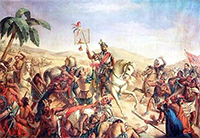Diego Velázquez: Conqueror of Cuba
Diego Velázquez de Cuéllar was a Spanish explorer who led the conquest of Cuba and served as governor of that island for many years during the 16th Century. 
He was born in Cuéllar in the 1460s, in Segovia, Spain. Little else is known of his life before he served in the military, in Naples. He lived in Seville until joining Christopher Columbus on his second voyage to New World, in 1493. He spent the rest of his life there. Columbus left his brother Bartholomew in charge of the island of Hispaniola, and Velázquez stayed with him and a group of other colonists. They endured hard struggles, including regular run-ins with the Taino, the people who lived there. Velázquez proved himself worthy of command and served as head of the Spanish contingent when Bartholomew Columbus was away. Velázquez also served as a key lieutenant to the new island governor, Nicolás de Ovando, who arrived in 1501. Velázquez led the founding of five new settlements on the island; he lived in one of those, Salvatierra de la Zabana, and won the right to administer them on Ovando's behalf. Columbus's oldest son, Diego, became governor of Hispaniola in 1509. One of his orders from the homeland was to expand Spanish influence beyond Hispaniola, starting with Cuba. Columbus chose Velázquez to lead that expedition. Velázquez led a troop of 300 soldiers (including future explorers Hernán Cortés and Pedro de Alvarado) in an expedition of colonization in 1511. The Spaniards found fierce resistance from the Taino people who lived year, but Spanish manpower and weaponry turned the tide and by August, Velázquez and his men had established the settlement of Baracoa, on the northeast corner of Cuba. 
In 1513, Velázquez led an expedition to establish settlements further west. Páfilo de Narváez, recently arrived from Jamaica, led another expedition. Within a year, they had taken control of most of the islands and, more significantly, found gold. Dotting the island eventually were a network of Spanish settlements, including Bayamo, Havana, Puerto Principe, Sancti Spiritus, and Trinidad. Velázquez established his headquarters in what he named the capital, Santiago de Cuba. At Velázquez's direction, Francisco Hernández de Córdoba was the first European known to visit the Aztec civilization. He and a force of 100 Spaniards arrived, from Cuba, in 1517. After a brief tour of the area, he asked Velásquez to send a larger force. After another expedition the following year, led by Juan de Grijalva, Spain agreed on a larger mission; this time, the leader was Cortés. He and a few hundred men arrived in 1519 at the head of a force of a few hundred soldiers. Their mission was to established contact and, if possible, trade with people living in Mesoamerica. The result was the conquest of the Aztecs, in 1521. Velázquez had sent an armed force under Narváez to stop Cortés from doing so; it failed. Velázquez lost his governorship of Cuba for a time but regained it. In the meantime, Spain's King Charles I had recognized Cortés as governor of New Spain, ending Velázquez's dreams of ruling over the newly acquired territory. Velázquez had married Maria de Cuéllar in 1513 in Baracoa. She died just a few days after they were married. He never remarried. He did, throughout his life in the New World, acquire great wealth. He still had that wealth when he died, in 1524, after a long illness. He was 59. |
|
Social Studies for Kids
copyright 2002–2025
David White




